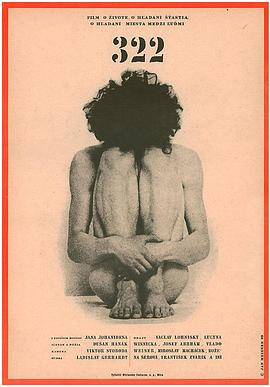『 夜车1959 』
“ 去年過世的波蘭導演耶吉‧卡瓦萊洛威茲,是「Polish Film School運動」中的代表人物之一。其作品擅長以影像呈現細膩的細節,累積給予觀者強烈的震撼力。...
| 演员 | 卢茜娜·温尼斯卡 / 莱昂·涅姆奇克 / Teresa Szmigielówna |
| 导演 | 耶尔齐·卡瓦莱罗维奇 |
| 地区 | 其它 |
| 语言 | 其它 |
| 类型 | 爱情片 |
| 豆瓣 | 8.2 |
| 年份 | 1959 |
| 更新 | 2023-02-12 |
相关影视推荐
修女乔安娜
卢茜娜·温尼斯卡,安娜·齐皮勒夫斯卡,玛丽亚·赫瓦利布格,弗朗齐歇克·皮耶奇卡,Halina Billing-Wohl,Mieczyslaw Voit,Kazimierz Fabisiak,Stanislaw Jasiukiewicz,Zygmunt Zintel,Jerzy Kaczmarek,Jaroslaw Kuszewski,Marian Nosek,Jerzy Walden,Marian Nowak,Zygmunt Malawski,Stanislaw Szymczyk
故事发生在十七世纪的波兰。书亚(Mieczyslaw Voit 饰)是一名德高望重的神父,坚定的坚持着自己对主的信仰和理想。某一日,他被派往了一间修道院中工作,有传闻魔鬼偷偷潜入了这间修道院,在其中作祟。 修道院的院长是一个名为乔安(卢茜娜·温尼斯卡 Lucyna Winnicka 饰)的女人,这个女人的身上散发出一股强大而又神秘的美丽,让众多的修女们为之疯狂。随着时间的推移,神父书亚发现魔鬼的力量实在是过去强大,仅凭他一人之力无法驾驭,于是向一个老法师寻求帮助。然而,最终,书亚亦没有能够拒绝魔鬼的诱惑,为了帮助乔安,他甚至犯下了杀人的罪孽。
法老
耶日·泽尔尼克,维斯瓦娃·马祖尔凯维奇,芭芭拉·布雷尔斯卡 Barbara Brylska
公元前11世纪,古埃及面临多重困难,外部有亚述人的战争威胁,又欠下腓尼基商人的大笔债款,国家濒临破产,人民穷困潦倒。拉美西斯十二世病重去世,他的儿子拉美西斯十三世被宣布为法老继承人。为了阻止埃及的迅速衰落,年轻的拉美西斯十三世决定夺取世世代代存放在神庙中的宝藏,将其用于社会改革和对亚述发动战争。但神职人员反对他的计划,祭司和年轻的法老之间开始了政治和宗教斗争。
322档案
Václav Lohniský,卢茜娜·温尼斯卡,约瑟夫·阿布汉姆,米罗斯拉夫·马哈切克,弗兰季塞克·兹瓦里克,Vladimír Weiser,Emil Horváth St.,Viktor Blaho,Jana Svandová,Bozena Sérová,Marta Raslová,卡雷尔·奥古斯塔,Zdenek Blazek,Olga Chodáková,Milan Hrabinský,Michal Kozuch,米库拉斯·洛迪津斯凯,Anton Trón
Mannheim-Heidelberg International Filmfestival YearResultAwardCategory/Recipient(s) 1969 Won Grand Prize Dusan Hanák A government official in Czechoslovakia mistakenly believes he has cancer. He reasons his involvement in clandestine activities during the Stalin administration have fated him to die from a dreaded disease. He searches for inner peace as he feels the guilt of his past transgressions. This film tied for the Grand Prize at the Mannheim Film Festival in 1969. Slovak director Dusan Hanak was one of Czech cinema's brightest and best talents of the '60s and '70s, but because of censorship this was not manifest until the late '80s. Dusan made an impact on the film world with his auspicious debut 322 (1969). Though banned until 1988, when it was finally released, it earned international acclaim and the Grand Prix award at the Mannheim Film Festival. Hanak's sophomore effort, the documentary Obrazy Stareho Sveta/Image of an Old World (completed in 1972), was also not released until 1988 and neither was his 1980 film Ja Milujem, Ty Milujes/I Love You, You Love. Only Hanak's 1976 film Ruzove Sny/Rose-Tinted Dreams passed muster with censors and saw a timely release.
你往何处去
玛格达莱娜·米尔卡兹,帕维·德朗柯,博古斯瓦夫·林达
指挥官维尼裘斯(帕维·德朗柯 Pawel Delag 饰)深深的爱着身在罗马的人质公主丽姬娅(玛达琳娜·米尔卡兹 Magdalena Mielcarz 饰),于是,残暴的尼禄皇帝(克兹佐夫·马扎克 Krzysztof Majchrzak 饰)将丽姬娅赏赐给了维尼裘斯为妻。然而,丽姬娅公主是一个虔诚的基督教徒,她不能忍受维尼裘斯靠杀戮和掠夺过活,丽姬娅选择了离开维尼裘斯。 为了挽回丽姬娅,维尼裘斯找到了基督教的秘密集会处,开始聆听教义,试图理解基督教的核心思想,想通过此走进丽姬娅的内心。当维尼裘斯回宫时,尼禄皇帝正在焚烧罗马城,而丽姬娅就在其中,维尼裘斯闯入火海救出了爱人。皇后非常嫉妒维尼裘斯和丽姬娅之间坚贞的爱情,于是设计陷害。
等待方舟
耶日·斯图尔,克里斯提娜·杨达,卡里娜·谢鲁斯克,马里乌什·德莫霍夫斯基,马雷克·瓦尔切夫斯基,扬·诺维茨基,亨里克·比斯塔,莱昂·涅姆奇克,克兹佐夫·马扎克,斯坦尼斯瓦夫·伊加尔
Set in an underground dungeon inhabited by bundled, ragged human beings, after the nuclear holocaust. The story follows the wanderings of a hero through the situations of survival. People wait for the Ark to arrive and rescue them while their habitat falls apart. Delving deep into the dusty and long abandonded vaults of b-cinema in search of lost gems always leaves me with a bittersweet taste. On one hand the discovery of unexpected gems where no one would think them possible is a rewarding experience. On the other hand though it makes one wonder how many of these remarkable low-budget oddities, personal love affairs of directors never quite famous and now all but forgotten, have almost forever slipped from memory? n any case what we have here is a little post-apocalyptic gem from Poland that is really better than it has any right to. The dystopian near future of O-BI, O-BA finds a group of survivors of the nuclear war that ravaged the Earth inhabiting an underworld concrete bunker and biding their time as they wait for the mysterious Ark, an air ship of some kind that will come and save them. The Ark proves to be an elaborate hoax, carefully designed to give hope to the malnourished and desperate denizens of the bunker, while in the meantime the dome that separates their miserable existence from the nuclear winter outside is slowly caving in. What first striked me about the movie is the design of the bunker and the depiction of the survivors. The survivors are gaunt, filthy and terrible-looking penitents, dressed in rags and aimlessly wandering the neon-lit halls of the bunker like automatons. The bunker is a rundown, seedy place, with bright neon lights peering from all sides like the eyes of malignant beasts. On one hand it is a slightly 80's depiction of the dystopian future but the movie never stoops down to MAD MAX cheese. Instead it combines biting political satire with the bleak outlook of a world with no future, black comedy with barbs on apathy, religion and power. The survivors, for example, are fed some kind of flour dropping from a tube that hovers in the air - later on we discover the food supervisor uses books and the Bible itself as filler for this meagre meal. There are many such short symbolic touches, perhaps not life-changing or faith-restoring, yet playful, clever and inspired. One thing is for sure; O-BI, O-BA is not your run-of-the-mill sci-fi schlock. It overcomes its modest budget with creativity and has genuine artistic aspirations both from a writing and directing perspective. My opinion is that it should have been filmed in black and white instead of colour though. The director uses atmospheric light and shadow to great effect and it would have registered even better in stark black and white. The blue-green neon on the other hand outstays its welcome after a while. Just a minor gripe in an otherwise solid b-movie with its heart set in all the right places. Imagine a less bleak THE ROAD (Cormac McCarthy) being injected with the satire and humour of DR.STRANGELOVE and you're getting there. See it if you can find it.
华沙之战1920
达尼尔·奥勒布里斯基,娜塔莎·厄本斯卡,波利斯·席克,Jerzy Bończak,Adam Ferency,Bogusław Linda,Ewa Wiśniewska,Aleksandr Domogarow,Olga Kabo,Andrzej Strzelecki
波兰首部3D片《华沙保卫战》将于9月23日上映。该片反映了1920年波兰人民抵抗苏联红军入侵的著名战役,造价约830万美元,是波兰史上投入最高的影片之一。夹在世界上两个最好战的大国德国与俄罗斯中间的波兰俗称欧洲“垫脚布”——谁出门都要踩上一脚。正是一个多灾多难的国家对历史有种特殊的偏好,广从电影票房上来看,波兰史上最为卖座的四部影片《剑与火》、《塔杜斯先生》、《你往何处去》以及《卡廷惨案》全都是以历史事件为题材的影片。波兰人民的大国理想也只有通过电影这种艺术形式才能得到伸张和舒展。而这部《华沙保卫战》虽然没什么出奇之处,但从气势恢宏的预告片看到波兰的诗人、歌女、神父统统揭竿而起,对苏联两位领导人描绘也是“举重若轻”,倒流露一丝浑不吝的气魄。
夜茫茫
Elzbieta Starostecka,莱赛克· 泰来钦斯基,雅德维佳·巴兰斯卡,Czeslaw Wollejko,Lucyna Brusikiewicz,Irena Malkiewicz,安娜·迪姆纳,Gabriela Kownacka,马里乌什·德莫霍夫斯基,彼得·弗龙切夫斯基,Zbigniew Józefowicz,Janusz Bylczynski,Barbara Drapinska,Aleksander Gassowski,Wieslawa Kwasniewska
斯苔芬尼(Elzbieta Starostecka 饰)虽然出身平凡,但拥有着聪慧的头脑和善良的内心。她前往马修公爵(Czeslaw Wollejko 饰)家中担任家庭教师的职务,在一次偶然中邂逅了马修公爵的孙子瓦尔迪马(莱赛克· 泰来钦斯基 Leszek Teleszynski 饰)。斯苔芬尼不同寻常的气质和谈吐一下子就吸引了瓦尔迪马,令他坠入了爱河之中。 然而,这段贵族和平民之间的感情很快就遭到了瓦尔迪马的姑妈的强烈反对,她看中了一位名叫梅拉尼(安娜·迪姆纳 Anna Dymna 饰)的贵族小姐,认为她才是成为瓦尔迪马的妻子的最佳人选。然而,马修公爵对这段感情显然有着不同的看法,因为他年轻时也经历过同样的抉择。
妈妈不在家
玛莎·雷耶斯·阿里娅斯,马克西米利亚诺·纳贾·马奎兹,莱昂纳多·纳贾·马奎兹,刘思思,Johnson T. Lau,Kevin Medina,Josiah Grado,Marvin Ramírez,Alejandro Banteah,Edwin Ramírez,Aylin Payen,Shacty Díaz,María Teresa Herrera,Amy Puente,Celine R. Lopez
马克斯和里奥跟随母亲露西亚从家乡墨西哥移居到美国。她说他们会过上更好的生活,她还答应带他们去梦寐以求的迪斯尼乐园。现实的情况却是,孩子们每天被关在一个破旧狭小的房间里涂鸦,等待精疲力尽的妈妈下班归来。导演根据自身经历改编,描绘了一幅疏离而忧伤的童年画卷,以敏感而审慎的态度,勾勒出多元化社会及移民问题的痛点。
火之夜
Alejandra Camacho,Norma Pablo,Mayra Batalla,Memo Villegas,David Illescas,Eileen Yañez,Marya Membreño,Ana Cristina Ordóñez González,Teresa Sánchez,Olivia Lagunas,Gabriela Núñez,Julián Guzmán Girón,Giselle Barrera Sánchez,Dolores Gutiérrez Hernández,Blanca
通过从三个青春期少女的眼睛看到的战争中的小镇生活。
爱情或面包
寇寇·马汀,安吉丽卡·庞阿尼班,Gelli de Belen,Ketchup Eusebio,Cai Cortez,Matet De Leon,Dante Rivero,Teresa Loyzaga,诺曼·Z·麦克劳德,平克·阿马多,Cheska Iñigo,Jeremiah Lisbo,Keith Dallison
Despite their attraction to each other and Leon's persistence in pursuing Angel, the latter's dream of becoming rich prevents them from having a lasting relationship.
童心无归处
Hannah Cagwin,Aeona Cruz,Liv Bagley,Shylee Sagle,Danika Toolson,Nicole Hamilton,Emma Winslow,Elle Walker,Jerry Cortese,Kit Thompson,Amy Dowd,Teresa Cocas,Stephanie Federico,Tamara Hutchins,Deb Hultgren
影片《童心无归处》讲述了世界上最轰动的一起谋杀案——美国六岁选美小皇后琼贝妮特·拉姆齐的死亡之谜。该案经过长达二十年的不休争议,屡次登上《时代》周刊和《人物》杂志封面,各大新闻媒体不断猜测凶手究竟是谁,而公众对其亲生父母及其学校一位男老师可能是凶手的指责更是甚嚣尘上。 影片《童心无归处》在纪实和非纪实之间游走,向观众呈现了一种非常奇特的电影风格,再现了小明星难解的死亡之谜。
流浪的心
莱昂纳多·斯巴拉格利亚,Miranda de la Serna,伊娃·略拉克,伊凡·冈萨雷斯,Alberto Ajaka,图卡·安德拉达,罗德里戈·多斯·桑托斯,Beatriz Rajland,Juan Ignacio Ugüet,Benjamín Ruiz,Veronica Hassan,Vanesa Maja,玛格丽塔·莫菲诺,Patricio Aramburu,Diego Almeida
阿根廷导演莱昂纳多·布列奇茨基执导,莱昂纳多·斯巴拉格利亚、迪奥戈·阿尔梅达(Diogo Almeida)主演新片[快爱上了](Almost in Love,暂译)首发剧照和片场照。影片围绕着饱受焦虑困扰的父亲桑迪亚戈(斯巴拉格利亚饰)展开,他十几岁的女儿想要远离他,这样复杂紧张的关系也加剧了他的情感危机。一个穿梭于阿根廷和巴西的混乱夏日,却成为了双方改变生活的催化剂。影片由[巴克劳]&[水瓶座]摄影师佩德罗·索特罗掌镜,玛丽亚·加尔斯克([看不见的女人])担任执行制片人。影片将于2020年上映。





















